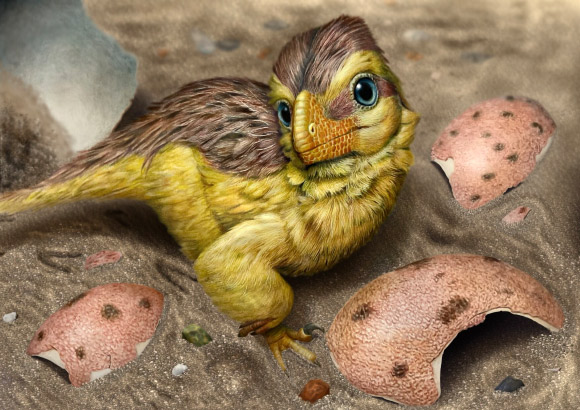Scientists from Stellenbosch University and elsewhere have used advanced uranium-lead (U-Pb) dating and elemental mapping to measure trace amounts of uranium and lead inside the calcite of fossilized dinosaur eggshells found in the United States and Mongolia.

An artist’s reconstruction of a newly-hatched troodontid-like dinosaur among fragments of its eggshell. Image credit: Eva Utsukiyouhei.
Many fossil sites around the world are only coarsely dated.
Without precise information on the geologic age of fossils, paleontologists struggle to understand how different species and ecosystems relate across time and space.
Usually, they rely on dating minerals such as zircon or apatite found associated with fossils, but those minerals aren’t always present.
Attempts to date the fossils themselves, such as bones or teeth, have often produced uncertain results.
Stellenbosch University’s Dr. Ryan Tucker and colleagues took a different approach: they used advanced U-Pb dating and elemental mapping to measure trace amounts of uranium and lead housed inside the calcite of fossilized dinosaur eggshells.
These isotopes function like a natural clock, enabling scientists to determine when the eggs were buried.
Tests on dinosaur eggs from Utah in the United States and the Gobi Desert in Mongolia showed that the eggshells record ages with an accuracy of about 5% relative to precise volcanic-ash dates.
In Mongolia, the researchers determined the first-ever direct age — around 75 million years old — for a historic locality preserving dinosaur eggs and nests.
“Eggshell calcite is remarkably versatile,” Dr. Tucker said.
“It gives us a new way to date fossil sites where volcanic layers are missing, a challenge that has limited paleontology for decades.”
By showing that dinosaur eggshells can reliably record the passage of geologic time, the study links biology and Earth science in a new way — offering researchers a powerful tool to date fossil sites around the globe.
“Direct dating of fossils is a paleontologist’s dream,” said Dr. Lindsay Zanno, a paleontologist at North Carolina State University and the North Carolina Museum of Natural Sciences.
“Armed with this new technique, we can unravel mysteries about dinosaur evolution that used to be insurmountable.”
The team’s work was published in the journal Communications Earth & Environment.
_____
R.T. Tucker et al. 2025. U-Pb calcite age dating of fossil eggshell as an accurate deep time geochronometer. Commun Earth Environ 6, 872; doi: 10.1038/s43247-025-02895-w







